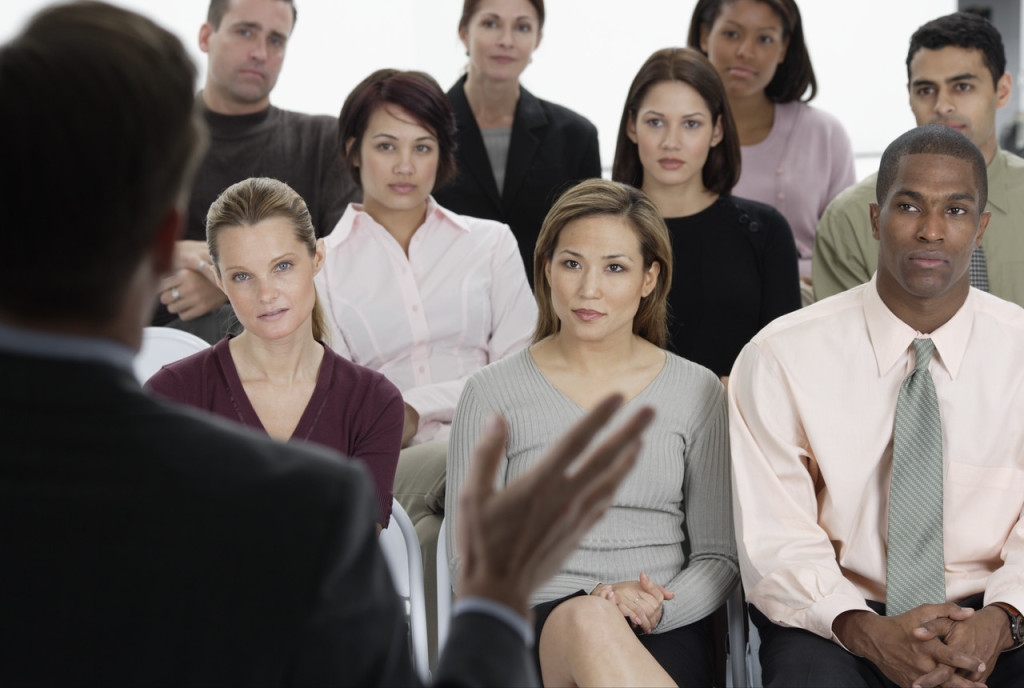Whether you’re brand new to public speaking or a seasoned veteran, one thing remains the same – you should always find your “partners.”
A “partner” is a term coined by TED speaker and author of “Start with Why” - Simon Sinek. And you may have heard of them referred to before but by a different name – as professional speaker, Dr. Michelle Mazur calls them SAMs (Spectacular Audience Members).
Regardless of the name the premise behind them remains the same – they are audience members that help you calm your nerves to feel comfortable on stage. And most often without even realizing it, their body language represents eagerness and approval in what you’re saying which is what every speaker needs to see and feel when presenting or speaking to groups.

FLICKR IMAGE @Corbis
Â
How to identify partners in a group
Every audience should have a few – they’re the folks that are on your side before you’ve already stepped up to the lectern on the stage.  And when you’re speaking to the group, you’ll notice them because their body language is screaming, “Yes, yes! I understand what you’re saying, and I like where you’re going with this.”
Once you know what you’re looking for in an audience member, finding a “partner” or two is easy.  The non-verbal cues you’re looking for are most evident when scanning the crowd during your presentation, but you can try to find them as soon as you take the stage as well.
The following are telltale signs of a partner or SAM in the audience:
- They’re leaning forward.
- They’re smiling.
- They’re laser-focused on you.
- And my personal favorite, they’re nodding their head in understanding and approval. Interestingly, the head nod is an inborn gesture of submission and agreement. Researchers uncovered this knowledge when they analyzed people who were born blind and found that they too made these gestures for same reasons.
Now an audience member doesn’t need to do all of these to be considered a partner. They’re the “you’ll know them when you see them” kind of enigmas.
Partners are what help a presenter go from feeling like their energy is low and their presentation is lacking in making them feel like they’re giving the speech of a lifetime.
Already have experience presenting to groups? Think back to one of your best presentations, did anything, in particular, stand out to you? Often, when reflecting on an excellent presentation speakers will cite specific audience members as helping them along the journey and giving the needed boost of confidence and energy to help the performance go from good to great.
What to do if there aren’t partners in the group
Because being a “partner” isn’t a real thing to look for or notice beforehand, you’ll have to assume that your audience will contain a few. Or at least one.
However, some experts think that you can not only identify them ahead of time but also create a few before you take the stage. Some people will tell you that if you’re unsure of the people in attendance that you should head into the conference room or area where you’ll be speaking early and get to know a few folks. By understanding them and building a connection with them beforehand, you can rely on that during the presentation to give you the boost of confidence that you may just need to hit a presentation out of the park.
And if you aren’t able to mingle beforehand, select an audience member you can rely on for this particular reason – to be a SAM/Partner. Be like a magician and plant them (they do that, right?) in the audience. Explain to a friend, coworker, or audience participant (that you already know) that you’re a little nervous and would love just to have them listen in to your presentation and smile once in a while when you two lock eyes.
How to become a partner to help others
The best way to find the best partners is to be a partner yourself.
And whether we realize it or not, being an attendee in an audience, we are communicating.
Even as attendees, our body language is unintentionally communicating various things like how we are feeling, what we’re thinking, and also can reveal just how present we are during their speech. Have you noticed your eyes are darting around the room looking at others, or perhaps they’re locked on the presenter? Maybe you’re leaning way back in our seat with our legs outstretched – or maybe you’re sitting straight up with our legs crossed and arms folded. Help a fellow speaker reach new heights by being their partner. Or if the unfortunate situation of a presenter not living up to their potential occurs, help them out by smiling and nodding your head in agreement.
Now all this “partner” stuff may seem like small details, but as anyone who has experienced this before can tell you – applying this new-found knowledge can be game-changing for a speaker/presenter of any level. And finding partners in the audience is not a nice-to-have for experts – it’s a must-have.
So what about you – have you experienced a partner in an audience before? How has it helped or transformed your energy and overall presentation? Feel free to share your thoughts below.Â